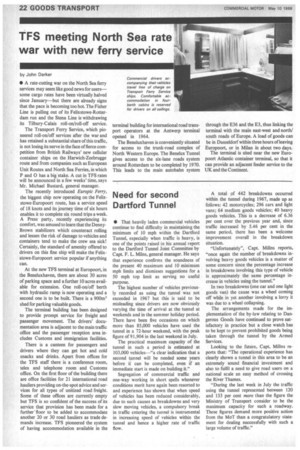TFS meeting North Sea rate war with new ferry service
Page 24

If you've noticed an error in this article please click here to report it so we can fix it.
by John Darker
• A rate-cutting war on the North Sea ferry services may seem like good news for users— some cargo rates have been virtually halved since January—but there are already signs that the pace is becoming too hot. The Fisher Line is pulling out of its Felixstowe-Rotterdam run and the Stena Line is withdrawing its Tilbury-Calais roll-on/roll-off service.
The Transport Ferry Service, which pioneered roll-on/off services after the war and has retained a substantial share of this traffic, is not losing its nerve in the face of fierce competition from British Railways' new cellular container ships on the Harwich-Zeebrugge route and from companies such as European Unit Routes and North Sea Ferries, in which P and 0 has a big stake. A cut in TFS rates will be announced in a few weeks' time, says Mr. Michael Bustard, general manager.
The recently introduced EUropie Ferry, the biggest ship now operating on the Felixstowe-Europoort route, has a service speed of 18 knots and its journey time of six hours enables it to complete six round trips a week. A Press party, recently experiencing its comfort, was amused to learn that the DennyBrown stabilizers which counteract rolling and lessen the risk of damage to vehicles and containers tend to make the crew sea sick! Certainly, the standard of amenity offered to drivers on this fine ship will make the Felixstowe-Europoort service popular if anything can.
At the new TFS terminal at Europoort, in the Beneluxhaven, there are about 30 acres of parking space and a further 10 acres available for extension. One roll-on/off berth with hydraulic ramp is now operating and a second one is to be built. There is a 900m2 shed for parking valuable goods.
The terminal building has been designed to provide prompt service for freight and passenger movement. The drivers' documentation area is adjacent to the main traffic office and the passenger reception area includes Customs and immigration facilities.
There is a canteen for passengers and drivers where they can get hot and cold snacks and drinks. Apart from offices for the TFS staff there is a conference room, telex and telephone room and Customs office. On the first floor of the building there are office facilities for 21 international road hauliers providing on-the-spot advice and services for all types of unitized road freight. Some of these offices are currently empty but TFS is so confident of the success of its service that provision has been made for a further-floor to be added to accommodate another 20 or 30 road hauliers as trade demands increase. TFS pioneered the system of having accommodation available in the
terminal building for international road transport operators at the Antwerp terminal opened in 1964.
The Beneluxhaven is conveniently situated for access to the trunk-road complex of North Western Europe. The Benelux Tunnel gives access to the six-lane roads system around Rotterdam to be completed by 1970. This leads to the main autobahn system through the E36 and the E3, thus linking the terminal with the main east-west and north/ south roads of Europe. A load of goods can be in Dusseldorf within three hours of leaving Europoort, or in Milan in about two days.
The terminal is sited near the new Europoort Atlantic container terminal, so that it can provide an adjacent feeder service to the UK and the Continent.












































































































